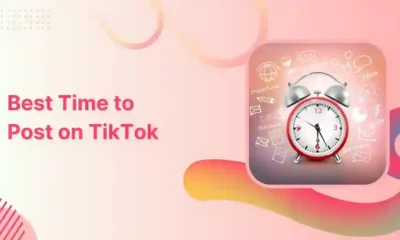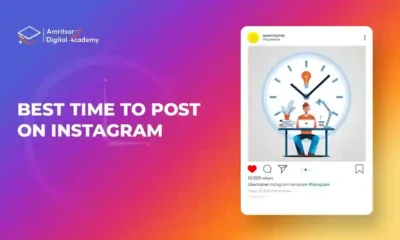Social Media
Time is of the Essence: A Comprehensive Analysis of LinkedIn Posting Times

In the dynamic world of professional networking, where connections are forged and opportunities abound, mastering the art of LinkedIn posting is crucial. While crafting compelling content is undoubtedly important, the timing of your posts can significantly impact their visibility, reach, and engagement. This comprehensive analysis explores the intricacies of LinkedIn posting times, offering insights into the best times to share content for maximum impact and why timing is indeed of the essence in the realm of professional networking.
Understanding the LinkedIn Algorithm
At the heart of the LinkedIn experience is its algorithm, a complex system that determines the content users see in their feeds. This algorithm considers various factors, including engagement metrics like likes, comments, and shares, as well as the recency of posts. To crack the code of LinkedIn posting times, it’s essential to understand how the algorithm operates and tailor your posting strategy to align with its dynamics.
Best Times to Post on LinkedIn
- Morning Momentum (8:00 AM – 10:00 AM): Jumpstart the day by posting during the morning rush. Professionals are often checking their LinkedIn feeds as they settle into their workday, presenting an excellent opportunity to capture their attention.
- Lunchtime Lull (12:00 PM – 1:00 PM): Seize the midday break when professionals take a pause from work. Posting during lunchtime can engage individuals seeking a brief update or industry news during their break.
- Afternoon Productivity (3:00 PM – 5:00 PM): Combat the post-lunch slump by sharing content during the mid-afternoon. Professionals may be more open to a brief distraction, increasing the visibility and engagement of your posts.
- Evening Wind-Down (7:00 PM – 9:00 PM): As the workday concludes, professionals often turn to social media, including LinkedIn, for updates. Posting in the early evening allows your content to be part of their unwind routine, potentially garnering more attention.
- Strategic Saturday Mornings (Saturday 10:00 AM – 12:00 PM): Challenge the notion that weekends are a social media downtime by strategically posting on Saturday mornings. With fewer updates in the feed, your content has a better chance of standing out among professionals catching up on industry news.
Factors Influencing Optimal Posting Times
- Know Your Audience: Tailor your posting times based on the habits and preferences of your target audience. Consider factors such as their industry, job roles, and geographic location. Understanding your audience is foundational to determining the most effective posting times.
- Global Considerations: If your network spans across different time zones, consider the global aspect of your audience. Posting at times that accommodate various time zones ensures your content reaches a diverse and international audience.
- Experiment and Analyze: The journey to finding the ideal posting times is not one-size-fits-all. Experiment with posting at different times and days of the week, and rigorously analyze the performance of your posts using LinkedIn analytics. This iterative process allows you to identify patterns and fine-tune your posting strategy.
- Stay Informed about Algorithmic Changes: Social media algorithms are dynamic, and LinkedIn’s is no exception. Stay informed about any changes to the algorithm that could impact the visibility of your content. Adaptability is key to ensuring continued success on the platform.
The Importance of Timing in Professional Networking
- Capitalizing on Peak Activity: Strategic posting times align with peak activity periods when professionals are actively engaged on LinkedIn. By capitalizing on these windows, you increase the likelihood of your content being seen and engaged with.
- Building a Consistent Presence: Regularly posting at optimal times contributes to building a consistent presence on LinkedIn. A consistent presence fosters familiarity among your connections, making your profile and content more memorable.
- Demonstrating Relevance: Posting when your audience is most active demonstrates relevance and attentiveness. It shows that you are aware of your audience’s habits and are intentional about delivering content when it is most likely to be well-received.
- Maximizing Engagement Opportunities: Timing your posts strategically creates more opportunities for engagement. Whether it’s a comment, like, or share, engaging with your audience during peak activity times amplifies the impact of your content.
Strategies for Maximum Impact
- Consistent Posting Schedule: Establishing a consistent posting schedule fosters anticipation among your audience. Regularity signals reliability, and users are more likely to engage with your content if they know when to expect it.
- Leverage LinkedIn Analytics: Dive into the valuable insights provided by LinkedIn analytics. Monitor metrics such as impressions, clicks, and engagement rates. This data-driven approach enables you to understand the performance of your posts and make informed adjustments to your posting strategy.
- Engage Actively with Your Audience: The social aspect of social media is vital. Actively engage with your audience by responding to comments on your posts, participating in relevant discussions, and fostering a sense of community. Increased engagement not only boosts visibility but also strengthens your professional relationships.
- Diversify Your Content: Experiment with different types of content, including text posts, images, videos, and articles. The LinkedIn algorithm values diversity, and varied content types can enhance your visibility and cater to different preferences within your audience.
- Harness the Power of Hashtags: Incorporate relevant hashtags into your posts to increase discoverability. Research and use hashtags that align with your content and industry to broaden the reach of your posts beyond your immediate network.
Conclusion
Time is undeniably of the essence when it comes to LinkedIn posting. A comprehensive analysis of posting times involves understanding the LinkedIn algorithm, identifying optimal time slots, considering factors that influence posting times, and recognizing the importance of timing in professional networking.
As you embark on the journey of cracking the code of LinkedIn posting times, remember that success is not static. It requires a dynamic and adaptive approach. Regularly reassess your posting strategy, analyze performance data, and stay attuned to changes in user behavior and platform algorithms. By mastering the art of timing on LinkedIn, you’re not just sharing content; you’re strategically shaping your professional narrative, building meaningful connections, and positioning yourself for success in the competitive landscape of professional networking.
Related posts:

Categories
- Apps (1)
- Automotive (23)
- Beauty (7)
- Business (117)
- Celebrities (2)
- Digital Marketing (21)
- Ecommerce (1)
- Education (18)
- Entertainment (25)
- Events (6)
- Features (4)
- Fitness (10)
- Food (1)
- Forex & Crypto (15)
- General (105)
- Health (48)
- House (61)
- Lifestyle (48)
- Marketing (8)
- Parenting (3)
- Pets (10)
- Real Estate (7)
- Safety and Security (11)
- Social Media (20)
- Sports (96)
- Technology (67)
- Travel (22)



















